
"The Micronauts: Gil Kane Thinks Small" Amazing Heroes #7 Dec. 1981
 |
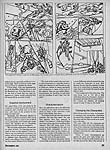 |
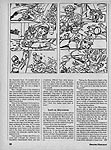 |
 |
|
Gil Kane
has drawn countless comics series for Marvel, DC, and many other publishers
over the last 30-plus years. He has always brought to his work a distinctive
personality, an intelligence that gives his work a consistent quality
above and beyond his amazingly skillful command of the craft. When we
learned that Kane was taking over the penciling of the Micronauts, we
knew that he would approach this strip with the same kind of thoughtfulness
that characterized his stints on such books like Captain Marvel, Captain
Action, and Green Lantern in the past. With this in mind, we visited Kane
at his Westport, Ct. residence, accompanied by a tape recorder and a slew
of questions.
|
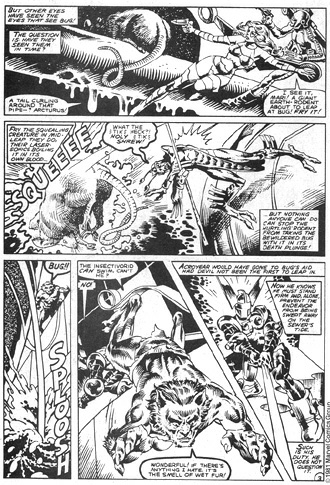 |
The Concept A Hard Book
to Draw |
|
Creative
Involvement
We asked Kane if he was going to be creatively involved beyond drawing from someone else's finished plot, as he has been with many of the projects he has been involved with. "Originally, Jim (Shooter) alluded to me that I would be involved in that, but at this point no one's come to me or asked me to participate and I simply get scripts where the narrative line is completely worked out and I have to interpret it. But at this point, like any artist, given an inch, I'm imposing my own point of view on the material. I have to. And so my own feelings for movement, for action, and for interpreting the characters is different from Broderick's, as Broderick's was different from Golden's - and for that matter different from Chaykin's. The truth of the matter is that each inker who is imposed on a penciler tends to adjust the material to suit himself as well so while you adhere to certain standards and conventions in terms of the look of the material, there are very subtle distinctions between the handling of each artist and the handling of each inker over the artist." |
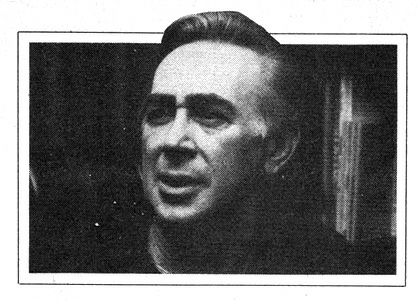 |
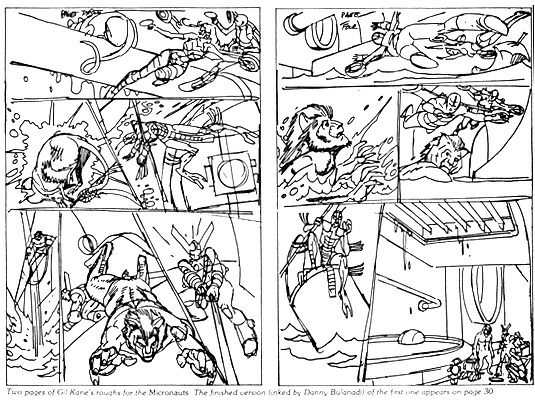 |
|
Characterization
Changing
the Characters |
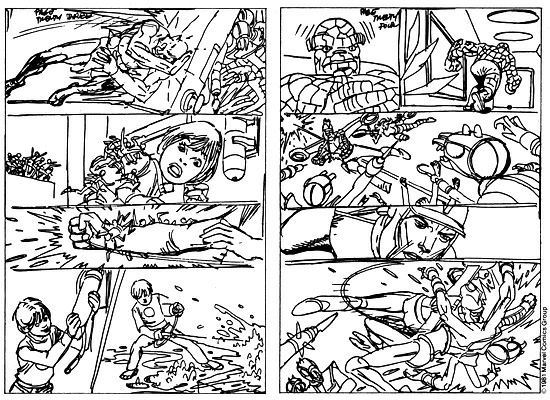 |
Earth
vs. Microverse
Kane's discussion of the concepts behind the Micronauts reminded us of the controversy over whether the Micronauts' adventures should take place on Earth or in the Microverse - a controversy that has apparently not yet been settled among the creators of the strip themselves. "I myself wish the strip were back in the Microverse, because it's the logical thing to do. To me the real value of the Micronauts is the Microverse, which created their characterization, created the entire context for the material, and is obviously the place for them to get back to. Taking the Micronauts to Earth is like all of a sudden taking all of the characters from Star Wars and bringing them into Brooklyn. You could do it, but what the hell is the point? I just finished a story dealing with their being stuck in a sewer in New York City. I can see a certain value just in the contrast, their being down in the sewer and going through the drain pipes and sewer line, they fight rats…you might be able to get a couple of interesting pictures, but those are obvious pictures and there's no story behind the picture." |
|
"But
when they're In the Microverse they're able to deal with relationships,
because that's where they're all rooted. As a result there are natural
problems arising out of the situation that we are not getting out of them
coming to the city. To me, having them come to the city just has shock
value and nothing else. I think the only way for the material to succeed
is to be true to itself and be true to Mantlo's conception, unless somebody
else comes in-but I don't think anyone else has the interest in the material
Mantlo has. Mantlo is the watchdog of the material and I think he has
to be true to his own instincts about it, otherwise they're going to be
a pastiche, which ultimately will exhaust all the attempts to hype it
up."
|
 |
|
How
Bill Mantlo created a universe
How did the Micronauts come to be? Unlike most such merchandising comic books, which are the product of business deals, Micronauts came straight from the creator of the book: Bill Mantlo. "My son had just reduced a mountain of X-Mas presents to disposable rubble," Mantlo wrote in an issue of Comics Journal a few months before the issue came out, "and sat, in the midst of this mess of paper, tearing a group of tiny shiny figurines out of their vacuum sealed packages. The figures seemed to catch the sparkle of the lights from my parents' Christmas tree. They were unlike any toys I had ever seen - and I've run the gamut in my time, from Dodge City to G.I. Joe to the Shogun Warriors. I asked Adam (that's my son's name) if I could see them before they went the way of all plastic and, when he handed them to me, I held in my palm the four basic figures of a new concept in toys called…The Micronauts." Standing there that Christmas morning, Mantlo began to fantasize, to make up the foundation for what would soon become one of Marvel's most popular series. "I envisioned them as small, microscopic even", Mantlo remembered, "inhabiting an other-verse apart from, but conjunctive with ours." Not only did Mantlo create the basic concept for the comic, but he began to consider the possibilities for characterization the characters possessed. "Space Glider seemed to suggest a Reed Richards nobility, an aspect of command, of dignity. Acroyear, faceless, his armor gleaming, a fantastic sword clenched in his coldly metallic hand, seemed to hearken back to a warrior Mr. Spock. For some reason Galactic Warrior seemed insect-like - I can almost hear clicks and whistles and strange scraping interjected into his speech. But Time Traveler…there was a mystery there, glimmerings of cosmic vastness, intimations of knowledge and space and time all having been broken down and reassembled to produce something entirely new… unexplainable…different." If this were you or I, we would just sit and indulge our fantasies for half an hour, perhaps, and then go on to our jobs. But Bill Mantlo's job consists in indulging his fantasies, and he knew he was onto something good. The following week, he walked into Marvel Editor-in-Chief Jim shooter's office and told him of his idea; Shooter, interested, got in touch with the manufacturer, Mego. "A month later," Mantlo went on, "we had preliminary photographs of the entire Micronauts line. I was, to say the least, floored. I had already begun extrapolating, based on just the four original figurines, a whole series of concepts. Now here, in front of me, were literally hundreds of additional figures, thousands of new suggested concepts…in effect, a whole world in need of a rationale for being." And thus, a Christmas present resulted in the creation of a whole fictional world- in a comic book that has now accumulated an impressive run of 40 issues and was, because of it's popularity, selected as one of three titles to be sold exclusively on the direct-sales market. Maybe Adam Mantlo deserves a co-creator credit on the book. After all, it was his toys that started it all. |
Thanks goes out to Geoff Gayan for supplying the scans of the magazine, and David Waugh Jr., for help in transcription